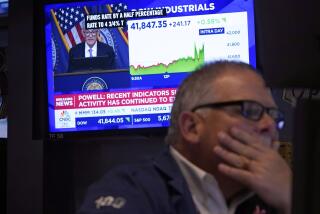Big Banks Cut Prime to 9.5%, Seven-Year Low
NEW YORK — Some of the nation’s largest banks cut their prime lending rates by a half point today to 9.5%, the first time the key commercial borrowing rate at a major bank has been in single digits since the fall of 1978.
Morgan Guaranty Trust of New York, the nation’s fifth-largest bank, led the way in the latest round of reductions in the prime, a benchmark against which banks measure their interest charges on business loans.
It was followed at midday by Bank of America, the nation’s largest bank, and Citibank, which ranks second.
Others Fall in Line
Chemical Bank, the No. 6 bank; Bankers Trust, No. 8; First National Bank of Chicago, No. 9; Continental Illinois National Bank, No. 13, Security Pacific in California and several leading regional banks, including Mitsui Manufacturers Bank, also went to 9.5%. California’s Union and Crocker banks followed later in the morning.
California Federal Savings & Loan, the nation’s No. 4 savings and loan association, also announced that it was matching that rate.
Analysts had been predicting a cut in the prime rate for several weeks because of declines in money-market interest rates which banks pay for their lendable funds.
The last time major banks cut their prime rate was when it was lowered to 10% from 10.5% on May 15.
Lowest Since 1978
The prime rate was last as low as 9.5% for two weeks in September, 1978. It had not been below 10% since it was raised to that level from 9.75% on Oct. 13, 1978.
Large businesses are often able to borrow at rates below the prime rate, while many smaller borrowers frequently must pay more.
The prime rate reduction could foreshadow declines in consumer rates on home equity, auto, student and mortgage loans, analysts said.
The prime rate is also important to Third World borrowers, many of whom pay interest charges pegged to the prime rate--usually a percentage point or more above it.
More to Read
Inside the business of entertainment
The Wide Shot brings you news, analysis and insights on everything from streaming wars to production — and what it all means for the future.
You may occasionally receive promotional content from the Los Angeles Times.









